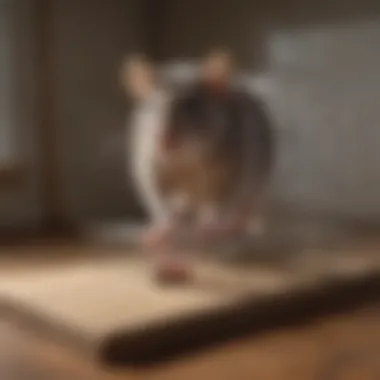Effective Strategies for Trapping Rats in Your House - A Comprehensive Guide


Preventive Pest Control Strategies
To safeguard your home from unwelcome rodent invaders, it is imperative to implement robust preventive pest control strategies. Beginning with the protection of your house exterior, focus on sealing cracks meticulously to thwart any potential entry points for pests. By employing expert tips for sealing cracks effectively and clearing debris from your surroundings, you elevate your home's defense against pest infiltration. Furthermore, emphasizing on preventing pests from entering your living spaces will establish a solid first line of defense.
In addition to house exterior protection, nurturing a well-maintained yard is crucial in deterring pests from making your property their breeding ground. The implementation of essential yard care routines ensures a pest-free environment, while methods tailored to keep your outdoor space pest-free pronounce your vigilance in controlling pest infestations. Simultaneously, maintaining indoor cleanliness through expert cleaning tips and techniques is paramount in upholding a pest-resistant indoor environment, a sanctuary for you and your loved ones.
Efficient waste management through proper garbage disposal methods plays a pivotal role in your endeavors to mitigate pest attractions. Highlighting the importance of conscientious waste disposal not only aids in pest control but also contributes to promoting a hygienic living environment. To complement these strategies, explore innovative ways to safeguard your home through various other pest prevention techniques that fortify your home's defenses comprehensively.
Understanding Rat Behavior
Rat behavior is a crucial aspect to consider when tackling rodent infestations in your abode. By understanding the behavior patterns of these pesky intruders, homeowners can develop effective strategies to combat them. Rat behavior encompasses various elements such as activity periods, nesting habits, and dietary preferences. Knowledge of these factors aids in devising targeted trapping methods that yield higher success rates.
Identifying Common Rat Species
Norway Rats
Norway rats, also known as brown rats, are one of the most prevalent rat species found in residential areas. They are distinguishable by their robust build and brown fur. These rats are adept burrowers, often creating extensive underground tunnel systems for shelter and nesting. Their omnivorous diet and high reproductive rate make them challenging pests to control. Integrating Norway rat-specific strategies into your trapping endeavors can significantly enhance your pest management efforts.
Roof Rats
Roof rats, also called black rats, are notable for their agile climbing abilities and preference for elevated nesting sites. With sleek black fur and long tails, these rats are skilled acrobats that can access homes through rooftops and utility lines. Their fondness for fruits and grains makes them a nuisance in residential settings. Implementing targeted trapping techniques tailored to the behavior of roof rats can effectively reduce their population in your living space.
House Mice
House mice are tiny rodents with a distinctive pointed snout and large ears. These creatures excel in squeezing through small openings, gaining entry into homes with ease. House mice display prolific breeding habits, leading to rapid population growth if left unchecked. By understanding the behavioral traits specific to house mice, homeowners can employ trapping methods that capitalize on their preferences for nesting in warm, secluded areas.
Rat Habits and Preferences


Nocturnal Behavior
Rats exhibit nocturnal behavior, becoming active primarily during the night. This behavior stems from their instinct to avoid predators and carry out foraging activities under the cover of darkness. Leveraging their nocturnal tendencies in trapping efforts involves setting up traps and baits during the evening to capitalize on their heightened activity levels. By aligning trapping schedules with rat behavior patterns, homeowners can maximize the effectiveness of their pest control strategies.
Nesting Preferences
Rats display distinct nesting preferences, favoring secluded and secure locations for breeding and shelter. Understanding their affinity for nesting in undisturbed areas such as attics, basements, and wall voids is essential for targeting trapping locations. By identifying and addressing these preferred nesting spots, homeowners can increase the likelihood of trapping success and mitigate future infestations effectively.
Food Sources
Rats have omnivorous diets, feeding on a wide range of food items readily available in residential environments. Their keen sense of smell directs them towards sources of sustenance, including stored grains, fruits, and leftovers. By manipulating food sources to lure rats towards traps, homeowners can enhance the attractiveness and efficacy of their trapping methods. Identifying and disrupting access to these food supplies is integral to long-term rat control strategies.
Preventative Measures to Deter Rats
In tackling the pervasive issue of rat infestations, one must employ vigilant preventative measures to deter these vermin from infiltrating the sanctity of their home. An effective strategy towards rat control encompasses a multi-faceted approach, starting with the fundamental step of sealing potential entry points that may serve as gateways for these unwanted intruders. By recognizing and rectifying vulnerable areas in your household structure, you establish a formidable barrier against rat intrusion, safeguarding your living environment and promoting peace of mind. Prioritizing preventative measures not only addresses the existing rat dilemma but also acts as a proactive stance against future infestations.
Sealing Entry Points
In the realm of rodent control, the significance of sealing entry points cannot be overstated. Inspecting your residence for minute gaps and crevices that rats could exploit for entry is crucial in fortifying your defenses. This meticulous process entails a thorough examination of potential access points such as utility openings, vents, and gaps in building foundations. By diligently sealing off these openings using steel wool and caulk, you create a robust deterrent that impedes rat intrusion. The use of steel wool, renowned for its durability and resilience, coupled with the sealing properties of caulk, ensures a comprehensive barrier that is inhospitable to rodents, effectively deterring further encroachment.
Maintaining Cleanliness
Beyond physical barriers, the maintenance of cleanliness within your living space plays a pivotal role in rat prevention. Proper garbage disposal practices are paramount in eliminating potential food sources that attract rodents. By securely storing trash in sealed bins and promptly disposing of accumulated waste, you eliminate enticing incentives for rat scavenging. Furthermore, establishing regular cleaning routines not only enhances the aesthetic appeal of your home but also eliminates clutter and debris that could provide hiding spots for rats. Consistent sanitation practices not only bolster the efficacy of trapping methods but also contribute to a healthier living environment for you and your family.
Choosing the Right Trapping Method
After identifying common rat species and understanding their habits and preferences, the crucial next step in effectively managing rat infestations is selecting the appropriate trapping method. The choice of trapping method plays a pivotal role in the success of pest control endeavors. By opting for the right trapping method, homeowners can efficiently address rat problems and prevent future infestations. During the selection process, factors such as safety, efficacy, and environmental impact should be carefully considered to ensure the chosen method aligns with humane and eco-friendly practices. Through a systematic approach to trapping, homeowners can create a pest-free environment within their households.
Live Traps


When it comes to humane pest control, live traps offer a compassionate solution for capturing rats without causing them harm. The benefits of live trapping include the ability to capture rats alive, allowing for their safe relocation to outdoor environments away from human dwellings. Live traps are particularly suited for individuals seeking non-lethal methods of rodent removal. Their design ensures that trapped rats remain unharmed, promoting conservation and ethical treatment of these creatures.
Proper placement techniques are crucial for the success of live trapping efforts. Placing live traps in strategic locations frequented by rats increases the likelihood of capturing these pests. Avoiding obstacles that may deter rats from entering the traps is essential, enhancing the efficiency of live trapping strategies. By adhering to best practices in trap positioning, homeowners can optimize the effectiveness of live traps and minimize the recurrence of rat infestations.
Snap Traps
Snap traps are a classic yet effective method for rat extermination. These devices are designed to swiftly eliminate rodents upon triggering, offering a quick and efficient solution to rat problems. Types of snap traps vary in design and mechanism, allowing homeowners to choose a model that best suits their trapping needs. The simplicity and affordability of snap traps make them a popular choice among individuals seeking a practical and reliable pest control solution.
Choosing the right bait is crucial for the success of snap trapping. Effective bait options entice rats into the traps, increasing the likelihood of a successful capture. Commonly used baits include peanut butter, cheese, and dried fruits, known for their strong appeal to rats. By selecting appropriate bait and placing it strategically within snap traps, homeowners can optimize their trapping endeavors and achieve desired results.
Glue Traps
Though controversial, glue traps are sometimes used in rat control due to their adhesive nature. Understanding how to effectively utilize glue traps is essential for maximizing their potential in rodent capture. These traps work by ensnaring rats upon contact with the sticky surface, immobilizing them until disposal. When used correctly, glue traps can be an effective method for capturing rats.
Safety considerations play a crucial role in the use of glue traps. Due to their adhesive nature, glue traps have the potential to harm unintended targets, such as pets or small animals. Implementing safety measures, such as placing traps out of reach of non-target species and using protective gear during trap disposal, is essential to prevent accidents. By prioritizing safety when employing glue traps, homeowners can effectively manage rat infestations while minimizing risks to non-target organisms.
Implementing Trapping Strategies
Implementing effective trapping strategies is crucial in successfully managing rat infestations in your household. By employing a systematic approach to trapping, homeowners can efficiently control the rodent population and maintain a hygienic environment. One of the key elements of implementing trapping strategies is the strategic placement of traps and diligent monitoring of their effectiveness. These strategies not only target existing rat populations but also prevent future infestations, offering a comprehensive solution to a common household problem.
Placement Techniques
Strategic placement in high-traffic areas
Strategic placement in high-traffic areas plays a fundamental role in the success of trapping rats. By identifying high-traffic zones where rats frequent, homeowners can significantly increase the chances of trapping the rodents effectively. These areas may include dark corners, along walls, or near sources of food and moisture. Placing traps in these strategic locations capitalizes on rats' natural movement patterns, maximizing the traps' efficiency. Additionally, high-traffic areas are more likely to yield quicker results, expediting the process of eliminating rats from your home.
Avoiding obstacles


When implementing trapping strategies, it is essential to avoid obstacles that may impede the traps' effectiveness. Common obstacles include furniture, clutter, or other items that could deter rats from approaching the traps. By creating clear pathways to the traps and removing potential barriers, homeowners improve the traps' visibility and accessibility to rats. Additionally, avoiding obstacles reduces the likelihood of traps being accidentally triggered by unintended objects, ensuring that the traps remain primed for capturing rats.
Monitoring and Checkpoints
Regular inspections
Regular inspections play a critical role in evaluating the success of trapping strategies and making necessary adjustments. By conducting frequent inspections of the traps, homeowners can assess whether the traps have been triggered, indicating potential captures. Regular inspections also allow homeowners to identify any issues with the traps, such as damage or malfunction, ensuring that the trapping process remains uninterrupted. Additionally, inspecting the traps regularly helps homeowners gauge the severity of the rat infestation and adjust their trapping methods accordingly.
Resetting traps as needed
In conjunction with regular inspections, resetting traps as needed is a vital component of trapping strategies. Once a trap has captured a rat or if it has been triggered without success, promptly resetting the trap is essential to maintain the trapping momentum. By resetting traps, homeowners ensure that the traps remain active and ready to capture additional rats. This proactive approach increases the traps' efficiency and prevents any lulls in trapping activity, ultimately leading to a more effective rodent control strategy.
Eco-Friendly Disposal Methods
Eco-friendly disposal methods play a pivotal role in the overall rat trapping process, ensuring not only a humane approach but also environmental sustainability. By prioritizing eco-friendly practices, homeowners can effectively manage rat infestations while minimizing the ecological impact. These methods promote a safer living environment for humans and other wildlife inhabiting the area. Utilizing eco-friendly disposal methods sets a responsible example for sustainable pest management practices. Proper disposal not only tackles the immediate rat issue but also contributes to a more harmonious ecosystem within and around the house.
Humanely Releasing Trapped Rats
Safe relocation practices
Safe relocation practices stand as a cornerstone of humane rat trapping methods, focusing on the ethical treatment of these pests. Through safe relocation, trapped rats are transferred to alternative locations without causing harm to them. This approach aligns with the compassionate perspective of resolving pest issues without resorting to lethal means. A key characteristic of safe relocation practices is the emphasis on minimizing stress and harm to the rats, ensuring their well-being throughout the process. The unique feature of safe relocation is its contribution to maintaining ecological balance by allowing rats to thrive in natural habitats, away from human dwellings. While safe relocation practices may require additional effort, the benefits of preserving life and promoting coexistence make it a worthwhile choice for ethical pest control.
Release in suitable habitats
Releasing trapped rats in suitable habitats is a vital component of safe relocation practices, ensuring the rodents' survival post-release. Suitable habitats provide rats with access to shelter, water, and food sources, increasing their chances of thriving in their new environment. The key characteristic of releasing rats in suitable habitats is the consideration of their natural requirements, mimicking their original living conditions as closely as possible. This approach is a popular choice for responsible rat disposal due to its focus on giving these animals a chance at survival outside human habitats. The unique feature of releasing in suitable habitats lies in the potential for rats to reintegrate into existing ecosystems without causing disruptions. While it requires careful selection of release locations, this method offers the advantage of maintaining the ecological balance by ensuring rats can adapt and live harmoniously in their new surroundings.
Proper Disposal of Deceased Rats
Wearing protective gear
Wearing protective gear is a fundamental aspect of handling deceased rats, safeguarding individuals against potential health hazards. Protective gear serves as a barrier between handlers and contaminants present on the rat's body, reducing the risk of exposure to diseases or parasites. The key characteristic of wearing protective gear is its role in preventing direct contact with rat remains, minimizing the chances of allergic reactions or infections. This practice is a beneficial choice for maintaining personal hygiene and safety during rat disposal activities. The unique feature of protective gear lies in its ability to provide a physical shield, ensuring individuals can conduct rat disposal procedures with confidence and protection. While wearing protective gear may seem like a standard practice, its advantages in preventing health complications highlight its essential role in safe and hygienic rat disposal.
Sanitizing contaminated areas
Sanitizing contaminated areas is essential for preventing potential health risks associated with deceased rats and their habitats. By sanitizing areas where rats have been found or disposed of, homeowners can eliminate harmful bacteria, parasites, and odors left behind by the rodents. The key characteristic of sanitizing contaminated areas is its focus on creating a clean and hygienic environment, free from any traces of rat infestation. This practice is a popular choice for effectively eradicating rat-related health hazards and maintaining a safe living space for occupants. The unique feature of sanitizing contaminated areas lies in its ability to restore the affected areas to a sanitary condition, reducing the risk of secondary contamination or illnesses. While it requires thorough cleaning and disinfection efforts, the advantages of sanitizing contaminated areas outweigh the potential health risks associated with neglecting proper sanitation practices.



